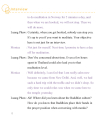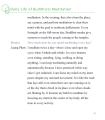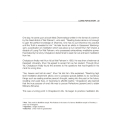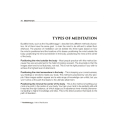Buddhist meditation : ค้นหาหนังสือธรรมะ หน้า 14 / 15
หน้าหนังสือทั้งหมด

101
Understanding the Pāli Verses and Buddhist Doctrine
The Text
The first nine leaves are inscribed with Pāli verses and a commentary in Tai Yuan.4 The final leaf of the manuscript is an addendum, inscribed with a stanza of the Dvatiṃsa-mahāpuruśa-lakkhaṇ
The manuscript presents Pāli verses and commentary in Tai Yuan, summarizing Buddhist doctrines about the Buddha's physical body and wisdom. It includes thirty stanzas highlighting qualities like divin

251
หลักฐานธรรมในคัมภีร์พระธรรม
หลักฐานธรรมในคัมภีร์พระธรรมนั้น 1 ฉบับประชาชน
Harrison, Paul M. 1990. The Samādhi of direct encounter with the Buddhas of the present: an annotated English translation of the Tibetan version of the P
เนื้อหานี้นำเสนอการสำรวจหลักฐานธรรมในคัมภีร์พระธรรมโดยการอ้างอิงงานศึกษาที่สำคัญเกี่ยวกับ Dhamma-kāya และความสัมพันธ์ระหว่างมันกับการบรรลุ enlightenment งานที่สำคัญเช่น เพื่อบันทึกการพัฒนาและการประยุก

559
Buddhist Literature and Manuscripts
Bailey, H. W. 1979. *Dictionary of Khotan Saka*. Cambridge: Cambridge University Press.
Banerjee, Anukul Chandra. 1979. *Sarvästivāda literature*. Calcutta: The World Press Private Limited.
Batchelor,
This collection features important works and studies related to Buddhist literature and manuscripts, covering a range of topics including the Khotan Saka dictionary, Sarvästivāda literature, and the s

83
Paleographical Analysis and Buddhist Manuscripts
Sander, Lore. 2000. “Appendix: A brief paleographical analysis of the Braāhmī manuscripts in volume I.” In J. Braarvig, eds., Buddhist manuscripts vol 1, pp. 285-300. Oslo: Hermes Pub. Original editio
This section presents a brief paleographical analysis of the Brahmi manuscripts in Buddhist texts as compiled by various scholars. Notable contributions include analyses by Sander (2000) on manuscript

50
Computerization of the Buddhist Pali Canon
The text in the image reads:
"The Computerization of the Buddhist Pali Canon
With the recognition that many world scholars have been impeded from fully studying the Buddhist scriptures by inconvenie
The Computerization of the Buddhist Pali Canon began in 1984 by the Dhammakaya Foundation to improve access for scholars worldwide. Utilizing the Romanized Pali Canon Text, the project produced a data

78
Kathina Day Celebration in Buddhism
Kathina Day
Kathina Day marks the end of Buddhist lent. It is the only festival in the Buddhist calendar when monks can be offered new triple robes. It is thus the most popular time for supporters to
Kathina Day is a significant celebration in Buddhism that marks the end of Buddhist lent. This unique festival is the only day in the Buddhist calendar when monks can receive new triple robes from the

72
Understanding Vinaya: The Code of Conduct in Buddhism
'Vinaya' means 'code of conduct', 'discipline' and 'regulations'on the behaviour of individuals. As a collection, it is the name of the first portion of the Buddhist Canon [Vinaya-piṭaka] which deals
Vinaya refers to the code of conduct governing the behavior of individuals within the Buddhist community, particularly monks and nuns. It encompasses the Vinaya-piṭaka, the first portion of the Buddhi

125
Understanding Key Buddhist Concepts
"Fools" (palay): spiritually defective people. A fool is someone wicked, weak, or feeble in a moral sense. His discretion is faulty, not knowing right from wrong, good from bad. A fool is one who give
This content delves into various Buddhist concepts such as 'fools'—spiritually defective individuals whose actions reflect moral weakness. It explains that heaven in Buddhism comprises six levels prov

56
Concepts in Buddhist Terminology
สังขาร (sankhara) compounded things; component things; conditioned things; kamma formations; mental formations; mental predispositions; essential conditions; conductive factors; conception; notion; th
Text discusses various Buddhist terms and concepts including 'สังขาร' (sankhara) which refers to conditioned things and mental formations. It details the concept of 'สังสาร' (samsara) as the cycle of

3
Analyzing the Dhammacakkappavattana Sutta: A Text-Critical Approach
The Document Research Methods
Case Study: The Dhammakakkappavattana Sutta
Pramaha Pongsak THANIO
Abstract
Dhammacakkappavattana Sutta (Sanskrit: Dharmacakaravartana
Sutra) is regarded as one of the
The Dhammacakkappavattana Sutta, a key Buddhist text, shows multiple versions arising after the Buddha’s death, raising authenticity questions. This research employs text-critical methods to establish

30
Vinayapitaka Editions and References
Vinayapitaka vol.IV. 2001. edited by Hermann Oldenberg. Oxford:
PTS. (first printed. 1882)
Vinayapitaka vol.V. 2006. edited by Hermann Oldenberg. Oxford:
PTS. (first printed. 1883)
อ้างอิงอื่น ๆ
PT
Vinayapitaka editions include volumes IV and V, edited by Hermann Oldenberg, published by the Pali Text Society with first prints in 1882 and 1883 respectively. Other important references include Nori

6
Exploring Early Buddhist Schools: Pāli and Chinese Connections
considered to have already appeared in the early Buddhist schools (Hinayāna) period at the latest and to have been widely recognized by at least two schools in company of them.
Throughout a study of t
This study examines the connections between Pāli and Chinese stanzas through early Buddhist schools, specifically focusing on: (1) Two Pāli stanzas aiding the understanding of Chinese transliterated t

4
The Role of Garudhamma in Buddhist Nuns' Conduct
a misplaced doubt about the rule that a nun must be given advice (ovāda)
and pointed out her bad behaviors (pavāraṇā) by a monk. Based on the
evidence in the Pāli canon, I make a clearer definition an
This paper examines the role of garudhamma in guiding the conduct of Buddhist nuns, highlighting their importance as norms rather than customs. It discusses the issues raised by a monk regarding advic

27
Creating a Heavenly Family through Dhammakaya
alcohol, gambling and adultery. If we resolve to live
virtuously, even to experiment with it for a period as
short as one month, we will see an immediate surge in
happiness within our family.
We refer
In pursuit of a happier family life, individuals are encouraged to resolve against alcohol, gambling, and adultery. By practicing meditation, families can reach the 'Dhammakaya' state, which symbolize

10
Meditation Insights from a Norwegian Interview
Interview
to do meditation in Norway for 5 minutes a day, and
then when we are hooked, we will not stop. Then we
will do more.
Luang Phaw: Certainly, when you get hooked, nobody can stop you.
It's up
In this insightful interview, Luang Phaw emphasizes the transformative power of meditation, encouraging a daily practice even if only for five minutes. Monica shares her experience of seeking calm aft

45
Daily Life of Buddhists Meditation
Daily Life of Buddhists Meditation
meditation. In the evening, they also clean the place,
say a prayer, and perform meditation to clear their
mind with the goal to eradicate defilements. Every
fortnig
The text discusses the daily meditation practices of Buddhists. In the evenings, they clean, pray, and meditate to clear their minds and eliminate defilements. Buddhist monks offer teachings every ful

33
An Ancient Secret for the New Millennium
An Ancient Secret for the New Millennium
together. But soon 30,000 people came, so it
became necessary to rent tents as before. With
the original straw-roofed Meditation Hall unable
to accommodate the
The text discusses the expansion of the World Dhammakaya Centre, initially constrained by the size of the Meditation Hall, which led to the need for larger accommodations. With over 320 hectares, the

72
Elements of Buddhist Lifestyle: Choice of Words
ELEMENTS OF BUDDHIST LIFESTYLE
55.Choice of Words
Words that hinder
others' stillness and peacefulness of mind
should never pass our lips.
Much less comments that discourage others
from practising med
This text emphasizes the importance of choosing words that foster stillness and peace in others. It suggests avoiding comments that discourage meditation and instead encourages speaking positively to

27
The Journey of Chaiyaboon in Meditation
One day, he came upon a book titled Dhammakaya written in the format of a sermon by the Great Abbot of Wat Paknam, who said: “Reading books alone is not enough to gain the perfect knowledge of Dhamma.
Chaiyaboon's quest for true understanding of Dhamma led him to the teachings of Khun Yai Chand at Wat Paknam. Through her guidance, he realized the reality of heaven and hell, the importance of medita

82
Types of Meditation
78 MEDITATION
TYPES OF MEDITATION
Buddhist texts, such as the Visuddhimagga¹, describe forty different methods of practice. All of them have the same goal: to train the mind to be still and to attain
Buddhist texts, like the Visuddhimagga, outline 40 meditation methods with the same goal of mastering the mind to achieve Buddhahood. Meditation can be categorized into three types: positioning the mi
